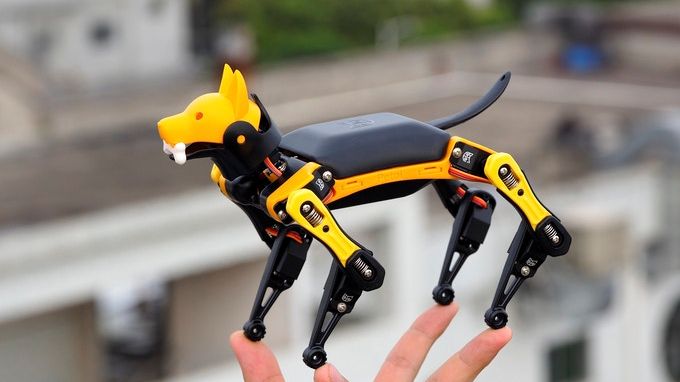5 Materials Used to Make Robot Pets: Which One is Most Durable?
Share
Table of Contents
Robot pets are becoming more common as companions, therapy aids, and interactive toys. One of the biggest concerns buyers have is durability. Since these pets are handled, hugged, or sometimes even dropped, the materials used in their construction make a huge difference. Understanding what robot pets are made of helps you see which option is most likely to last.
Why Do Materials Matter in Robot Pets?
The material choice affects more than appearance. It influences durability, weight, cost, and even how realistic the pet feels. A robot pet designed for children may use softer plastics or fabrics, while one meant for seniors may need sturdier shells to withstand daily handling.
Common Materials Used in Robot Pets
Plastic

Plastic is one of the most widely used materials in robot pets because it balances affordability with ease of manufacturing. It allows for a lightweight build, smooth finishes, and safe handling, which is especially important for children’s toys. However, not all plastics perform the same when it comes to wear and tear.
- Types used: ABS plastic, polycarbonate
- Advantages: Lightweight, affordable, impact-resistant
- Drawbacks: May scratch or crack over time, especially with frequent handling
- Durability level: Moderate – strong for casual play, but not the longest-lasting option
Metal

Metal is often used for the internal skeleton or frame of a robot pet, giving it structure and long-lasting durability. Unlike plastics, metal can withstand repeated impact and heavy use without bending or breaking easily. It is the go-to choice when manufacturers want maximum strength and protection for delicate electronics.
- Types used: Aluminum, stainless steel
- Advantages: Very strong, protects internal circuits, resists bending
- Drawbacks: Heavier, more expensive, less “pet-like” in feel
- Durability level: High – ideal for protecting the robot pet’s structure over the years
Silicone and Rubber

Silicone and rubber are often chosen for their soft, skin-like qualities that make robot pets feel more natural to touch. These materials are flexible, safe, and comfortable, enhancing the sense of realism for users who want an animal-like experience. Still, their softness makes them more vulnerable to damage.
- Advantages: Soft, realistic texture, gentle on touch
- Drawbacks: Easier to tear, attracts dust and dirt, may degrade with exposure to heat
- Durability level: Low to moderate – good for realism, but less protective overall
Fabrics and Plush Coverings

Many robot pets designed for comfort or therapy use plush fabrics or synthetic fur. These coverings make the pet feel warm, huggable, and approachable, creating a closer bond between user and robot. While comforting, fabrics are also the quickest to show signs of wear.
- Advantages: Makes pets cuddly and approachable, great for therapy settings
- Drawbacks: Absorbs stains, can wear down or rip, requires frequent cleaning
- Durability level: Low – not the best for long-term toughness, but highly comforting
Composite Materials

Some of the most advanced robot pets rely on composite materials, which combine plastics, metals, or synthetic fibers into one design. This allows for a balance between toughness and realism, offering the structural strength of metal with the softer feel of plastics or silicone.
- Advantages: Blend of plastics, metals, or synthetic fibers designed for balance
- Drawbacks: Can be costly to produce, not always recyclable
- Durability level: High – often the best compromise between strength and comfort
Which Material Is the Most Durable?
Metal, especially aluminum or stainless steel, is usually the most durable for robot pets. It resists impact, protects delicate electronics, and withstands years of use. However, it can make the pet feel less lifelike. That’s why many manufacturers use composite materials — combining metal skeletons with softer plastic or silicone exteriors to achieve both toughness and comfort.
What’s the Best Material for Children’s Robot Pets?
For kids, a balance of durability and safety matters. Sturdy plastics with some soft silicone parts often work best. These resist cracks while still feeling pleasant to touch and safe enough for play.
What’s the Best Material for Therapy Robot Pets?
In therapy or eldercare settings, comfort is the priority. Plush or fabric coverings create an inviting, pet-like experience, though they need more maintenance. Beneath these soft layers, durable plastics or composites are usually hidden to ensure longevity.
How Do Manufacturers Test Durability?
Companies test robot pets with:
- Drop tests from common heights
- Pressure resistance checks on joints and shells
- Long-term wear simulations (thousands of touches, bends, and strokes)
These tests help ensure the chosen materials won’t fail too quickly.
Final Thoughts
The durability of a robot pet depends on how it’s built and the materials chosen. If long-lasting performance is the goal, metals or composites are the strongest option. If comfort and realism matter more, plush or silicone coverings may be preferred, with internal structures still reinforced for protection. The best choice depends on whether the pet is meant for play, therapy, or companionship.


Our Social Media
Follow Us Follow Us Follow Us